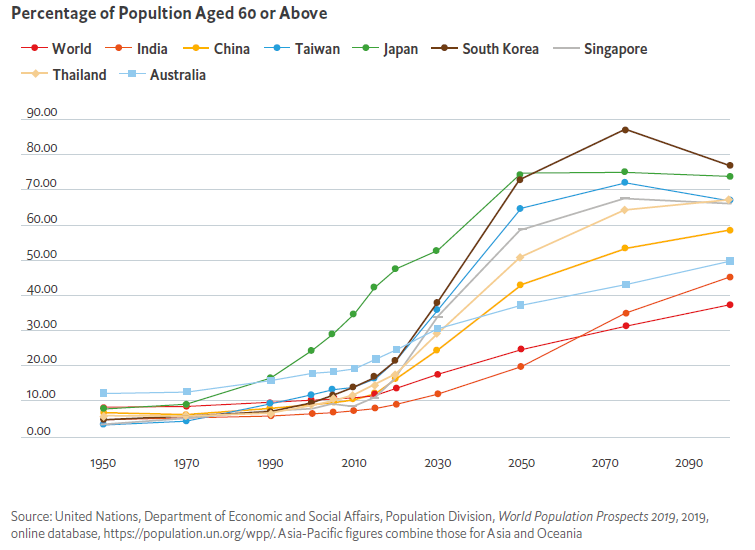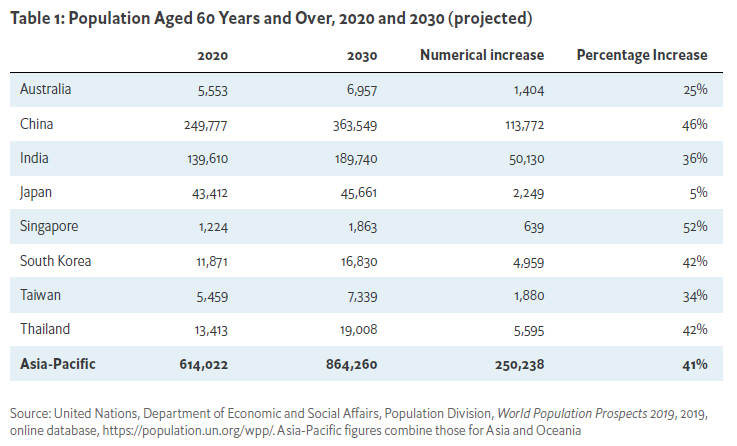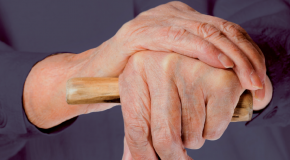Covid-19 has rightly seized the attention of health system officials. Nevertheless, the disease has done nothing to change the underlying consideration which led the WHO – and, just as recently, also the Asia-Pacific Economic Cooperation (APEC) and the G201 – to raise the policy profile of healthy ageing’s importance to economic growth and human well-being. More and more of us are living longer and longer. This is good news, but also presents challenges. One too often overlooked will be the need to address a rapid increase in the proportion of people susceptible to osteoporosis and its attendant, often devastating, bone fractures.
Ageing populations: Asia-Pacific in the lead
This demographic shift is most visible in Asia, with its unprecedentedly rapid population ageing. In the first half of the 21st century, the proportion of people aged 60 or more in many leading Asia-Pacific countries, and in the region as a whole, will roughly triple – in some cases quadruple. The partial exceptions, such as Japan and Australia, are countries where population ageing began earlier (Figure 1).

Such percentage figures in part reflect the region’s very low, by historic standards, birth rates. Also at play, though, is increasing longevity. Currently, of the jurisdictions covered by UN Population Division data, four of the five with the highest life expectancy are in Asia – Hong Kong, Japan, Macao, and Singapore – while Australia and South Korea also make the top 11. Newborns in all these places can expect to live 84 or 85 years.2
This growing longevity, along with limited but still positive population growth in much of Asia, is driving a rapid increase in the absolute numbers of older individuals across the region. In most major countries, the number of people aged 60 and above will, during the Decade of Healthy Ageing alone, rise by between roughly a third and a half. After that 10-year span, 250 million more over 60s will live in Asia-Pacific than when the decade started – 41% growth (Table 1).

Rapidly expanding osteoporosis risk
This rising longevity represents a societal and medical triumph. It also, though, brings substantial healthcare challenges. Age correlates with any number of noncommunicable disease (NCDs) such as diabetes, cancer, and cardiovascular diseases. These already represent a formidable burden on health systems and a challenge to governments seeking to provide sustainable health services. Nevertheless, their human and economic cost can be greatly reduced by primary and secondary prevention, early diagnosis, and effective treatment. Delivering these interventions for NCDs as a whole, though, remains very much a “work in progress” for most health systems. “We’re right at the point of inflection,” says Paul Mitchell, communications director and executive board member of the Fragility Fracture Network. “We’re entering a new demographic era. If we don’t radically change the way that we respond to the longevity miracle by putting into place systems that optimise recovery, prevent events and enable older people to lead independent lives as long as possible, then the human and economic costs will be dire.”
Osteoporosis provides one of the clearest examples of a challenge which health systems already need to address and which will become only more pressing with as Asia-Pacific’s population of older citizens burgeons. Some time around the age of 25 to 30, the typical person begins to experience a loss in bone mineral density (BMD). This continues to some extent throughout one’s life and accelerates in women during the years of menopause. Although some decline in BMD is natural, it can go too far. Put simply, osteoporosis is the term for when this process reduces BMD to a dangerously low level.
The link between ageing and osteoporosis prevalence is both clear and dramatic. South Korean national survey figures show that 15% of women in that country have the condition while in their 50s, but this proportion rises steadily over time so that 86% of those in their 80s. The equivalent figures for men, 4% and 27%, are less dramatic but still indicate a widespread health issue.3 Although comparable prevalence data from other countries are limited, South Korea’s figures are consistent with those found elsewhere. A study of a rural population in Henan, China, also saw a steady increase in the number affected from age 50 onward and had similar results to the Korean one for people in their 70s (female prevalence was 37% in both; male was 20% in Henan and 15% in Korea).4 An urban Indian study, meanwhile, found that, among its subjects average, BMD started below that of the Korean average for people in their 40s and then declined even more rapidly over time.5
From Osteoporosis to the Toll of Fragility Fracture
Osteoporosis does not diminish quality of life: many who have it fail even to notice. The clinical problem is the greatly heightened risk off fragility fractures – the term for breaks caused by events or injuries which would not under normal circumstances be expected to cause a fracture. These typically occur at the wrist, spine, and hip. All can be serious and represent health system challenges. For example, although many fragility fractures of the spine may initially be small, treatment of serious ones cost the South Korean National Health Insurance Service US$282m in 2016 – an increase of 46% from just four years earlier.6
That said, fragility fractures of the hip are generally the most serious ones and associated with the greatest healthcare burden. A study covering nine major Asian jurisdictions, which collectively have 70% of the continent’s population – China, Hong Kong, India, Japan, South Korea, Malaysia, Singapore, Taiwan, and Thailand – estimated that in 2018 these places 1.12m hip fractures.7
The resultant human and economic costs implications are likely stark. One-year mortality after a hip fracture in Asia – in both middle and high-income states – range between around 10% and around 25%, reaching 30% in India. This is consistent with outcomes in much of the rest of the world.8 Meanwhile those who do survive continue to face significant challenges. An extensive research review found that typically only around half regain their previous physical capacity.9 The economic cost is also substantial. The nine-nation study cited above calculated that the aggregate direct treatment costs in those countries reached US$9.5 bn in 2018.10
This same research provides worrying projections for the future: if nothing is done, demographic change alone will mean that by 2050 the nine countries it covers will see 2.56m hip fractures which health systems will need to spend US$15bn to treat, not accounting for any inflation.11
Finally, not all hip-fracture patients receive the necessary surgery due to the lack of access to affordable services in resource-limited or rural settings. Even where appropriate treatment is accessible and government-funded, costs for rehabilitation and prevention of second fractures are a burden. In Taiwan, for example, lower socio-economic status was related to an increased risk of death in the one year following a hip fracture.12
Now That We Have Your Attention…
Demographics are not destiny. Asia does not need to face what Dr Irewin Tabu, – a leading orthopaedist in the Philippines – calls the “tsunami of fragility fractures” that would go with rising osteoporosis prevalence. Potential interventions exist to prevent osteoporosis and its results: in individuals both young and old, appropriate lifestyle choices – including eating healthy foods, engaging in weight-bearing exercise, and not smoking – can help maintain BMD, thereby reducing the chances of developing osteoporosis; various medications can increase BMD, thereby decreasing the chance of fracture when osteoporosis is diagnosed; effective rehabilitation and secondary prevention after fractures can reduce the likelihood for further breakages (which are often worse than the initial ones).
With so many people affected by osteoporosis, any universal or universalising health system will need to take it seriously. In order to help stakeholders understand the scope of the challenge and possible options available to address it, the Economist Intelligence Unit, sponsored by Amgen, has published two important studies: Demystifying ageing: Lifting the burden of fragility fractures and osteoporosis in Asia-Pacific (2017)13 and Ageing with strength: Addressing fragility fractures in Asia-Pacific (2019).14 We are now building on this with the current article as well as a series of newsletters in the coming months to look at several of the most prominent issues in the area of osteoporosis and fragility fracture care. Future topics will include: the impact of Covid-19 on osteoporosis diagnosis, monitoring, and treatment; the state of care the Philippines and Thailand, two important Asian emerging economies; and innovations in policy advocacy and stakeholder cooperation to address this complex challenge. Please keep an eye out for these publications.





